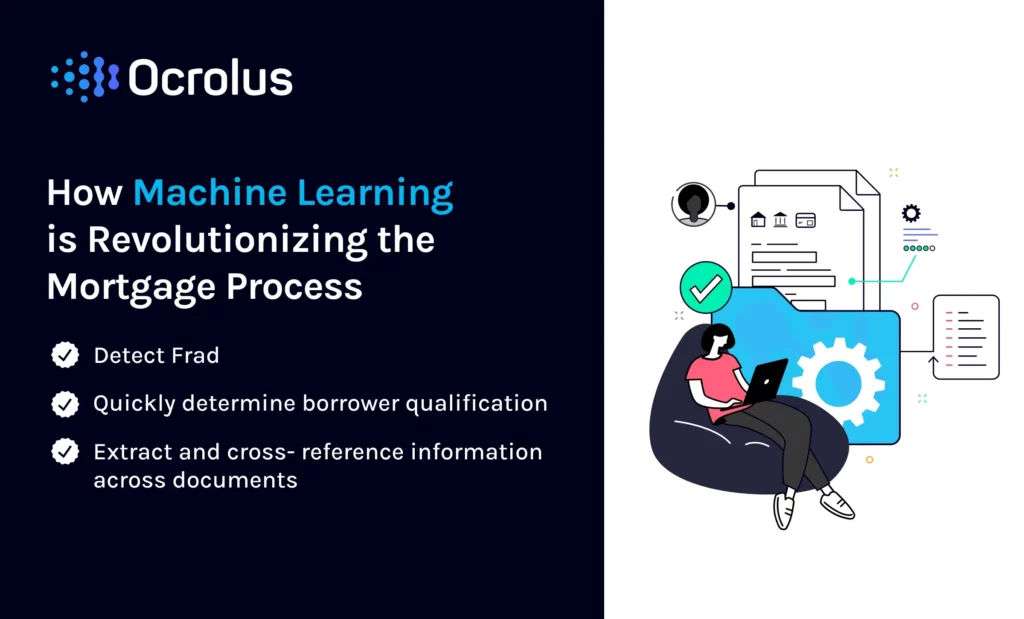How Machine Learning is Revolutionizing the Mortgage Process

In 2021, the mortgage market grew to $1.61 trillion, marking the highest mortgage borrowing numbers in history. However, by the end of 2022, mortgage demand plunged 13.2% due to climbing interest rates. Whether the industry is seeing unprecedented or fluctuating demand, the mortgage application process often leaves both lenders and borrowers with a desire for faster, improved processes.
Why does mortgage loan origination take so long?
Traditional mortgage lending processes are manual, slow and can feel outdated compared to the seamless digital experiences that have become the norm. Processing a mortgage application is often a tedious and time-consuming endeavor, requiring repetitive manual work and extensive back-and-forth communication. The traditional process places a heavy burden on borrowers and originators alike.
A borrower must be in frequent contact with the loan officer. Details such as a mismatched name or a missing piece of documentation can significantly delay an application’s approval. Human error can also throw an application off course, adding a disproportionate level of complexity and time to the process.
What does an automated mortgage solution look like?
Automation using machine learning accelerates the mortgage origination process, making it more efficient for borrowers and lenders alike. A successful mortgage automation solution begins at the document collection step by classifying borrower-submitted documents. The borrower is able to receive instant feedback so that any potential issues such as missing documents or incorrect statement dates can be quickly resolved. Once all required documents have been uploaded and verified, key data points can be extracted, cleaned, and validated, and provided to the lender. Additional checks such as verifying borrower income and categorizing income, assets, and tax forms can also be automated.
With clean, reliable, structured data, mortgage originators can make more informed, confident lending decisions. Further, a successful automated solution sharply reduces the number of manual processes needed to close the loan. By removing unnecessary manual steps, the likelihood of error is minimized, and the time to process is significantly reduced, allowing borrowers to get approved faster, and lenders to dramatically scale volume.
Manual lending processes also prevent lenders from efficiently processing applications. With varying loan volumes and differing mortgage products, lenders may not always have the staff to handle fluctuating processing volumes. By automating mortgage lending processes using machine learning techniques, mortgage originators can gain the operational agility required to navigate market fluctuations at scale.
Future-proof your mortgage workflow
Stay one step ahead of evolving technology. Download our eBook to build a trusted and efficient automated mortgage workflow.
Get your free eBookHow machine learning is enhancing analytics and fraud detection
Mortgage lending fraud continues to be an expensive problem for lenders. In fact, for some lenders, 1 in 20 loans will default, many without a single payment made. Machine learning enables fraud detection to be incorporated into an automated mortgage solution. Reliable fraud detection allows lenders to confidently and quickly approve trusted loans, and avoid unnecessary loss. Ocrolus’ automated fraud detection algorithm, Detect, can identify if a file, such as a bank statement, has been tampered with, and provides rich contextual visualizations and data on which fields (such as account number or account balance) have been modified.
Detailed visualizations allow credit and risk analysts to quickly assess any edits that have been made to a file, and make an informed decision on how to proceed. Additional signals can indicate if a file has been generated by the borrower rather than the bank. Further analytics can flag suspicious signals such as incorrect withholding amounts or determine if transactions do not add up correctly.
Improving the mortgage process with machine learning
Traditional mortgage lending processes are slow and cumbersome, often dependent on manual work, and necessitate back-and-forth communication between the borrower and the lender. These processes create a frustrating and opaque experience for the borrower, are tedious for the lender, and can dramatically limit the ability to scale.
Machine learning can be integrated to improve every stage of the lending process, from origination to closing. Ocrolus’ mortgage automation solution modernizes the process, creating a transparent and efficient workflow for borrowers, and helping lenders make smarter decisions in less time so that they can easily finalize loans ahead of deadlines.






